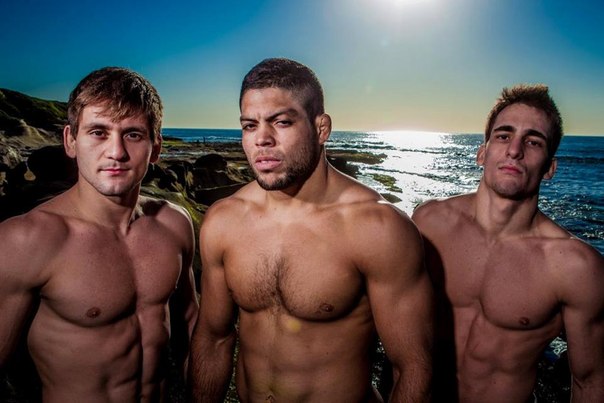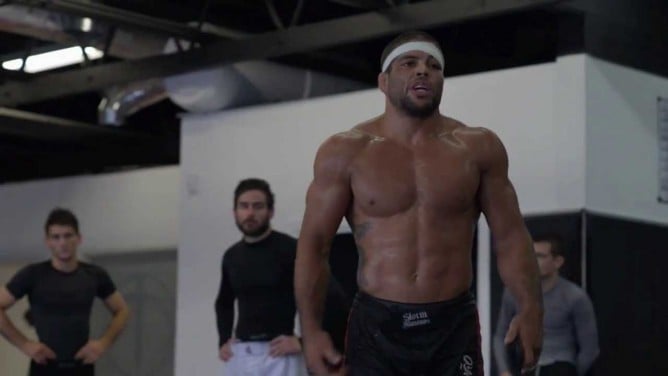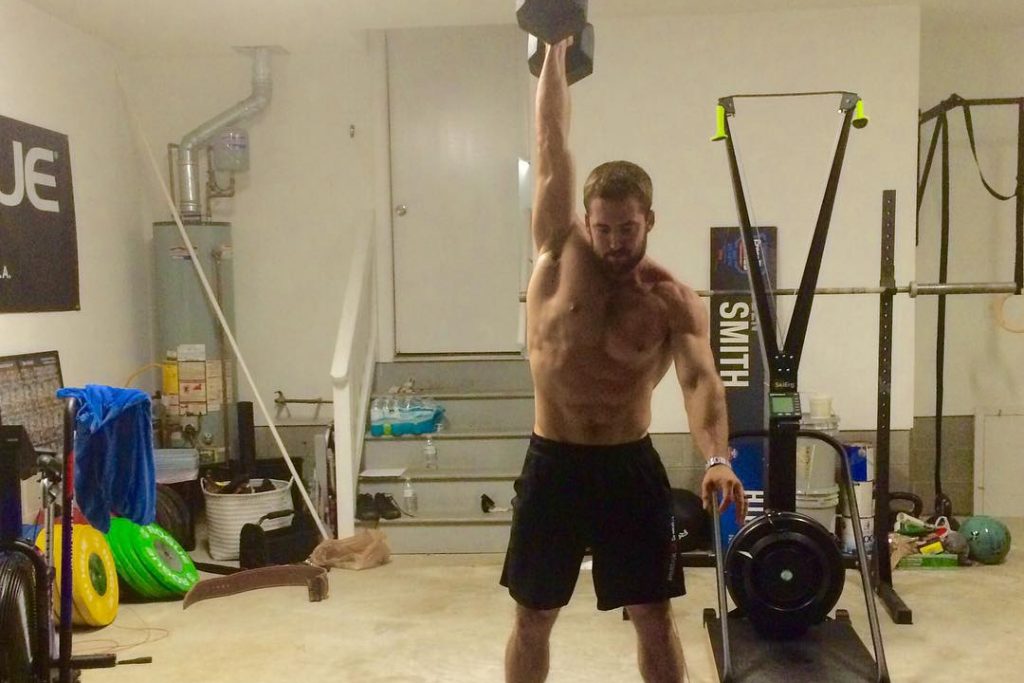
Looking at all the No-Gi action out there makes lots of grapplers yearn for that jacked and functioning BJJ body. Grapplers like Gordon Ryan, Andre Galvao, Cyborg and others. Seeing them makes everyone, regardless if they’re grapplers or not, drool over their physiques. However, there’s a recurring theme among BJJ athletes that makes them see muscle as the enemy of high-level BJJ. This article has the aim of achieving two main goals. First, I’d like to tackle the myth about muscle size and the ability to grapple. Second, I’ll offer a brutally simple, yet completely effective routine to help you pack on some muscle.
Training for grappling is different from bodybuilding. This is a statement we all know to be very true. To that extent, training for that jacked and muscular BJJ body also needs to be in line with the main physical activity – Jiu-Jitsu. As such, you need to look and find that hard-to-pin balance. You’ll need to put your body under enough intensity to grow, yet not get overly tired of BJJ. Unfortunately, you’ll have to make compromises. And by compromises, I mean lower the intensity of BJJ training, at least for a while. This doesn’t mean skipping classes, only watching out how hard you spar. So, if your next competition is in a couple of months, forget about building muscle. The best time to do it is in the off-season when you have time to spare.
Grappling Muscle
The first thing we’re going to focus on is what exactly is grappling muscle. As you know, Brazilian Jiu-Jitsu requires your body to work in a bunch of unusual ways. On top of it, you need to be limber and flexible enough along with having the endurance to go for long periods of time. So, where exactly does muscle fit in the puzzle? Or is the quest fora jacked BJJ body just a vanity goal?

Which brings us to performance. The jacked BJJ body is good for more than a show. Apart from strength and power, you’re also going to be able to perform better. Being stronger, and bigger helps with pins and makes make holding isometric positions a bit easier, and can get you out of a bad spot (or into a good one).
Another huge upside is injury prevention. Stronger muscles mean stronger tendons. that, in turn, means less accidental joint injuries and/or muscular ones. This is particularly important for grapplers older than 35.
How To Get A Jacked BJJ Body
When you’re looking to add that all-important few additional pounds of muscle, you need to make sure you keep things as simple as humanly possible. to that extent, there are two main things to focus on. One is knowing the few cardinal rules of weightlifting for grapplers. Rules translate into achievable goals. if you go doing what you think will work, you’re most likely to fail in both your quest for the ultimate BJJ body and Jiu-Jitsu. Second, you need a solid, tried, and tested program that is going to work for grapplers of all levels. Below, we got both.
A great way of getting that impressive BJJ body is by using a very simple tool – kettlebells. It has worked for Russian wrestlers for decades now, and it will work for you. Mike Perry, who is an outstanding grappler himself has the right recipe fro you. Get his DVD set “Kettlebell Essentials Instruction Guide” and become a jacked and shredded grappling machine!
Just before we go into it, let’s dispel the myth that bigger muscles mean less conditioning and less speed. If you decide to go bodybuilder big, for sure, all of the above applies. However, if you focus on building a few pounds of muscle, strategically placed all over major muscle groups, you’ll only benefit from it. furthermore, if you’re training right and not isolating muscle groups, your body is going to work as one unit. this means that you won’t compromise flexibility, (much), agility or endurance.
The Rules
Let’s go over the 5 cardinal rules of weight training for increased muscle mass for martial artists. The first one is something you’ve probably heard a bunch of times – train big muscle groups the most. This does not mean that you’ll leave your biceps or abs to just work when you do full-body movements. The legs, back, and chest are the groups that need to be your primary targets, with shoulders, biceps, and grip muscles following closely.
Next up, remember that to grow a muscle you need constant, specific stimulus. That, however, does not mean spending 6 days in the gym on top of BJJ training. It actually means pinpointing the correct volume of work, that’ll get you growing at a steady rate. The same goes for intensity. When it comes to this, be prepared for a trial and error period before you get everything spot on.
Next up is goal setting. do not forget that your goal is to get the best BJJ body, not the best beach body. It is very easy to get caught up in weightlifting, especially when you start getting jacked. Remember that grappling should be your primary focus and you shouldn’t overdo auxiliary training.
Also, do not expect your garden variety Muscle & Fitness “20 lbs in 8 weeks” program to work. If you want to build muscle you need to give it time. Otherwise, you’ll gain weight, but it won’t be just muscle. If you do not have at least six months to dedicate to getting a few pounds of muscle, do not even start training for it.
The final piece of the puzzle is correct nutrition. It is a deciding factor, yet one so important that it deserves an article of its own.
The Method
Finally, we can get to the program. It is a three-day split containing full-body exercises in each session. Make sure to train them a day apart at the very least. Furthermore, give yourself weeks’ time to test your max lifts on each of the given exercises. then, use that number to choose the weight you’ll train with. Every 8 weeks, retest yourself and increase the weight accordingly. Keep the reps and sets the same throughout the program. Finally, remember that this is a muscle-building program, not an endurance one. If you really want to get the jacked BJJ body of your grappling idols, learn to train with a full range of motion and rest for 2-3 minutes between sets.
Day 1
- Deadlifts (5 sets of 5 reps)
- Pull-ups (3 sets of maximum reps)
- Barbell rows with an isometric hold (3 sets of 8 reps. Try to hold the weight for 10 seconds in the contracted position)
- Three-way curls (3 sets of 5 reps of each variation – do 5 curls with your palms facing you, followed by 5 Hammer curls, followed by 5 curls with your palms facing away from you. That is one set)
- Hanging leg raises (5 sets of maximum reps)
Day 2
Bench press (5 sets of 5 reps. Lift explosively and lower the weight for 5 seconds).
- Standing military press (3 sets of 8 reps)
- Barbell shrugs (5 sets of 10 reps)
- Skull crushers (3 sets of maximum reps)
- Grip training (isometric holds, 3 sets of maximum holds, preferably hanging off a pull-up bar while holding on to a Gi)
Day 3
- Front squats (5 sets of 5 reps. If you think you can handle them, do Zercher squats instead)
- Split squats (4 sets of 10 reps on each leg)
- Close grip bench press (4 sets of 10 reps)
- SUPERSET – Ab wheel rollouts & medicine ball Russian twists (5 sets of maximum reps of each exercise)
- Neck bridges (3 sets of 30-second holds)
Travis Stevens’ 3 weeks / 3x per Week Weight Lifting Program for Grapplers


![Darce Choke Encyclopedia – Origins, Mechanics and Variations [2025] BJJ, choke, Brabo, BJJ Darce Choke, D'arce Choke, Darce BJJ Choke](https://bjj-world.com/wp-content/uploads/2017/11/JungPoirierLeeYahoo-218x150.jpg)







 Bench press (5 sets of 5 reps. Lift explosively and lower the weight for 5 seconds).
Bench press (5 sets of 5 reps. Lift explosively and lower the weight for 5 seconds).

![DONE! Gordon Ryan Retiring—and Danaher Might Not Be Far Behind! [2025] Gordon Ryan Retiring—and Danaher Might Not Be Far Behind!](https://bjj-world.com/wp-content/uploads/2025/04/LEG-GRABS-3-1-218x150.png)

![6 Most Essential Skills Base Top Dima Murovanni DVD Review [2025] 6 Most Essential Skills Base Top Dima Murovanni DVD Review](https://bjj-world.com/wp-content/uploads/2025/04/essential-skills-base-top-dima-murovanni-dvd-review-218x150.png)

![Cross Ashi Garami Firas Zahabi DVD Review [2025] Cross Ashi Garami Firas Zahabi DVD Review](https://bjj-world.com/wp-content/uploads/2025/04/cross-ashi-garami-firas-zahabi-dvd-review-218x150.png)

![Ultimate Study Tomoe Nage Neil Adams BJJ DVD Review [2025] Ultimate Study Tomoe Nage Neil Adams BJJ DVD Review](https://bjj-world.com/wp-content/uploads/2025/04/tomoe-nage-neil-adams-bjj-dvd-review-324x235.png)
![Front Headlock and Turtle Escapes Brian Glick DVD Review [2024] Front Headlock and Turtle Escapes Brian Glick DVD Review](https://bjj-world.com/wp-content/uploads/2024/11/headlock-and-turtle-escapes-brian-glick-dvd-review-100x70.png)
![No-Gi Pressure Mastery JT Torres DVD Review [2024] No-Gi Pressure Mastery JT Torres DVD Review](https://bjj-world.com/wp-content/uploads/2024/10/no-gi-pressure-mastery-jt-torres-dvd-review-100x70.png)

![Giancarlo Bodoni DVD Bundle Essential Connections Full Review [2024] Giancarlo Bodoni DVD Bundle Essential Connections Full Review](https://bjj-world.com/wp-content/uploads/2024/09/giancarlo-bodoni-dvd-bundle-essential-connections-100x70.png)

![Spider and Lasso Guard Jared Welman DVD Review [2025] Spider and Lasso Guard Jared Welman DVD Review](https://bjj-world.com/wp-content/uploads/2025/01/spider-and-lasso-guard-jared-welman-dvd-review-100x70.png)






![Countering Triangles And Omoplatas Adam Mazin DVD Review [2024] Countering Triangles And Omoplatas Adam Mazin DVD Review](https://bjj-world.com/wp-content/uploads/2024/10/countering-triangles-and-omoplatas-adam-mazin-dvd-REVIEW-100x70.png)

![Collar Sleeve Guard Mikey Musumeci DVD Review [2024] Collar Sleeve Guard Mikey Musumeci DVD Review](https://bjj-world.com/wp-content/uploads/2024/12/collar-sleeve-guard-mikey-musumeci-dvd-review-100x70.png)
![Don’t Stand Up Chris Wojcik DVD Review [2024] Don't Stand Up Chris Wojcik DVD Review](https://bjj-world.com/wp-content/uploads/2024/11/dont-stand-up-chris-wojcik-dvd-review-100x70.png)





![Trip Throw Dilemma Michael Pixley and Heath Pedigo DVD Review [2024] Trip Throw Dilemma Michael Pixley and Heath Pedigo DVD Review](https://bjj-world.com/wp-content/uploads/2024/10/trip-throw-dilemma-michael-pixley-dvd-review-100x70.png)


![Crossing and Spinning Steps To Attack Israel Hernandez DVD Review [2024] Crossing and Spinning Steps To Attack Israel Hernandez DVD Review](https://bjj-world.com/wp-content/uploads/2024/09/spinning-steps-to-attack-israel-hernandez-dvd-review-100x70.png)
![Front Head Lock Kaynan Duarte DVD Review [2025] Front Head Lock Kaynan Duarte DVD Review](https://bjj-world.com/wp-content/uploads/2025/02/front-head-lock-kaynan-duarte-dvd-review-100x70.png)